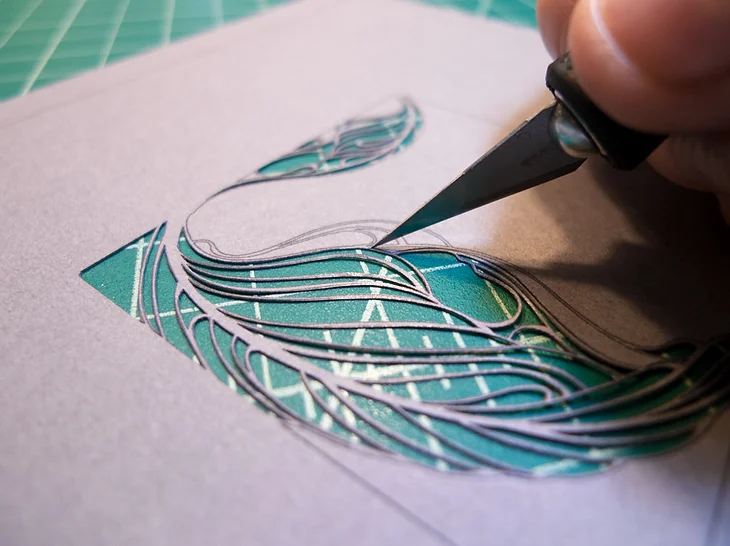My artwork begins life with the whisper of pen on paper

Why art?
A: You'll have to ask Art. It chose me by the age of four, perhaps even at birth.
What kind of artwork do you do?
A: I create sunken-relief sculptures by stacking together up to 100 layers of intricately cut paper, which I call Paper Strata.
What does your work aim to say?
A: I've never made a Paper Strata artwork with the aim of saying anything. My work is born from visions, so I focus on the graphic impact and textural experience while creating it. Only after a sculpture is finished can I reflect on what it might be trying to say.
What motivates and inspires you?
A: I'm greatly inspired by the organic patterns in nature, otherworldly landscapes, traditional motif design, and fairytales books from the Golden Age of Illustration. I'm motivated by the impulsive fire to always be creating, which I think most artists have.

What process do you go through mentally when you are creating a piece?
A: I begin with a vision of either a design or a color palette. Those two stages of my process (design and palette) generally take the most time and energy. Once I've resolved them to work well together, I move on to the template stage. This is when I often have to do some structural engineering to determine how to turn my 2D image into a 3D reality. The fourth stage, cutting, is a form of meditation for me. At this point the heavy lifting is done and I can simply get lost in the soothing rhythm of following the lines with my knife. The final stage is assembly, where I have to determine if the result works as intended, and if there are any ways I could improve the piece. Of course precision alignment is key to bring it all together.
What role does the artist have in society?
A: It inspires us to take a moment and appreciate the beauty in the world.
How do you navigate the art world?
A: In the same way I do my regular life; as a lone wolf who tries to be thoughtful in my interactions with the world.
How has your practice changed over time?
A: In some ways my practice has become streamlined as I figure out how to best execute things. In other ways I have had to learn how to slow down, and give my mind more space to dream, or an artwork more space to develop into its best version.

What is the biggest challenge of being an artist?
A: Finding time to make art for youself. When art is your job, you tend to focus on what you can sell. It's important to still have art hobbies; projects that you do just to feed your soul. Go ahead and experiment with different mediums, boldly make mistakes, and see where the unexpected path leads.
What themes do you pursue?
A: The only theme I intentionally pursue, is the Magic Portal. I love the idea/image of everyday objects becoming a place where you can embark on a grand imaginary adventure.
What is your dream project?
A: I have a design I've been sitting on for years, incorporating layers of etched and cut metal with layers of cut paper. I have the tools and supplies I need to do the metal parts sitting in my basement, waiting for me to have the time and courage to take it on.
What superpower would you have and why?
A: Immortality. There's simply too much to read, write, see, create, listen to, and experience for ten lifetimes, much less one.

What is the biggest mistake you have made within your career to this point?
A: Like many emerging artists, I foolishly spent years trying to make a living selling only originals.
How have other artists or art genres influenced your sense of aesthetics?
A: Art Nouveau and other movements from that ilk taught me how to draw my lines. Illuminated manuscripts and Islamic design helped develop my love of repeat pattern. But the greatest artist that has influenced my aesthetics and style—from working in layers, to my persistance in creating an atmosphere as apposed to focusing on a subject— is nature.
How do you know when a work is finished?
A: As a finisher/polisher, knowing when to walk away is one of the hard parts of making something. I try to always set a "finished" work aside for a few days and come back to it with fresh eyes, to see if it still feels done.

